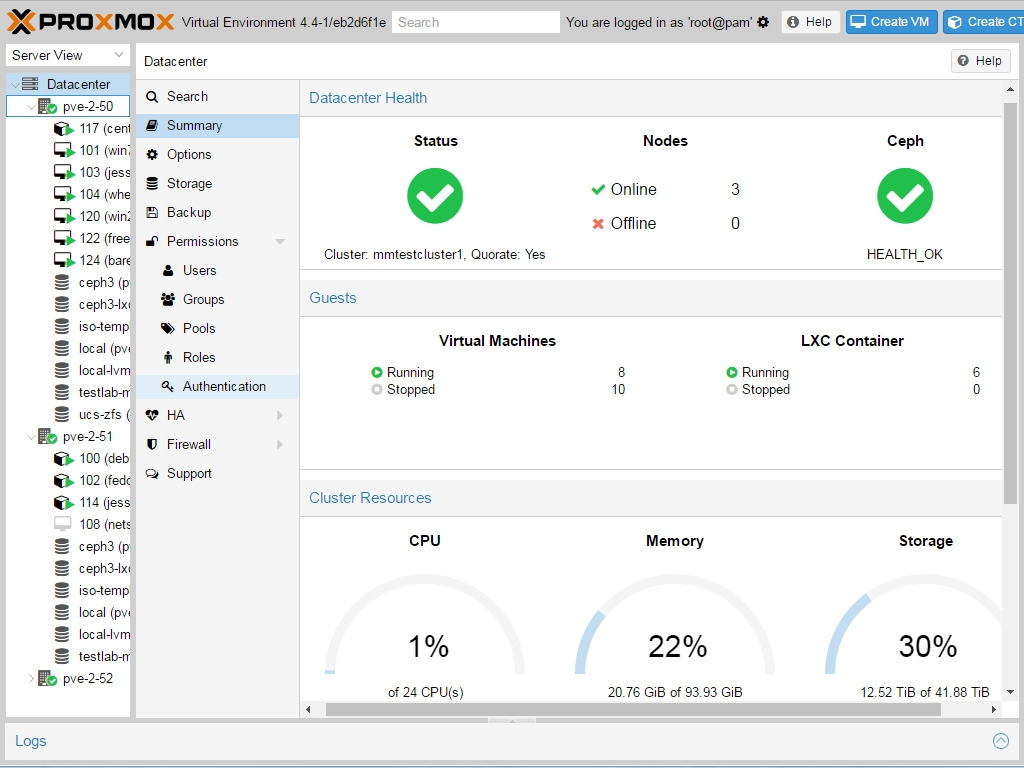Either self-hosted or cloud, I assume many of you keep a server around for personal things. And I’m curious about the cool stuff you’ve got running on your personal servers.
What services do you host? Any unique stuff? Do you interact with it through ssh, termux, web server?
This might be a better question for !selfhosted
Two old HP thin client PCs configured as 4TB SFTP file servers using vsftpd on Debian. Each one uses software RAID 1 with both an NVMe and SATA SSD internally, and are in two separate locations with a cron job which syncs one to the other every 24 hours.
People who actually know what they are doing will probably find this silly, but I had fun and learned a lot setting it up.
If it works reliably who cares?
tell me about the cron thing. im thinking of doing just that on mine for backup.
are you scping them together?
On my Raspberry Pi 4 4gb with encrypted sd is:
- pihole
- wireguard server
- vaultwarden
- cloudflare ddns
- nginx proxy manager
- my website
- ntfy server
- mollysocket
- findmydevice server
- watchtower
Pi is overkill for this kind of job. Load average is only 0.7% and ram usage is only 400M
findmydevice server
What server are you running for this?
can you tell us how you got this running with an encrypted SD card?
That was really hard to do. I created a note for myself and I will also publish it on my website. You can also decrypt the sd using fido2 hardware key (I have a nitrokey). If you don’t need that just skip steps that are for fido2.
The note:
Download the image.
Format SD card to new DOS table:
- Boot: 512M 0c W95 FAT32 (LBA)
- Root: 83 Linux
As root:
xz -d 2023-12-11-raspios-bookworm-arm64-lite.img.xz losetup -fP 2023-12-11-raspios-bookworm-arm64-lite.img dd if=/dev/loop0p1 of=/dev/mmcblk0p1 bs=1M cryptsetup luksFormat --type=luks2 --cipher=xchacha20,aes-adiantum-plain64 /dev/mmcblk0p2 systemd-cryptenroll --fido2-device=auto /dev/mmcblk0p2 cryptsetup open /dev/mmcblk0p2 root dd if=/dev/loop0p2 of=/dev/mapper/root bs=1M e2fsck -f /dev/mapper/root resize2fs -f /dev/mapper/root mount /dev/mapper/root /mnt mount /dev/mmcblk0p1 /mnt/boot/firmware arch-chroot /mntIn chroot:
apt update && apt full-upgrade -y && apt autoremove -y && apt install cryptsetup-initramfs fido2-tools jq debhelper git vim -y git clone https://github.com/bertogg/fido2luks && cd fido2luks fakeroot debian/rules binary && sudo apt install ../fido2luks*.deb cd .. && rm -rf fido2luks*Edit
/etc/crypttab:root /dev/mmcblk0p2 none luks,keyscript=/lib/fido2luks/keyscript.shEdit
/etc/fstab:/dev/mmcblk0p1 /boot/firmware vfat defaults 0 2 /dev/mapper/root / ext4 defaults,noatime 0 1Change
rootto/dev/mapper/rootand addcryptdevice=/dev/mmcblk0p2:rootto/boot/firmware/cmdline.txt.PATH="$PATH:/sbin" update-initramfs -uExit chroot and finish!
umount -R /mntThank you so much! will make a note of this
No problem ;)
You might like to search this community, and also \c\self_hosted, since this question gets asked a lot.
For me:
- Audiobookshelf
- Navidrome
- FreshRss
- Jellyfin
- Forgejo
- Memos
- Planka
- File Storage
- Immich
- Pihole
- Syncthing
- Dockge
I created two things - CodeNotes (for snippets) and a lil’ Weather app myself 'cause I didn’t like what I found out there.
how do you like freshrss? do you use it on mobile too?
Lenovo ThinkStation P330 Tiny. Debian + Podman systemd quadlets, running these services:
- Jellyfin
- Sonarr
- Radarr
- Qbittorrent w/ VPN
- Linkwarden
- Calibre Web
- Immich
- Lidare
- Postgres
- Prowlarr
- Vaultwarden
P330 tiny is so good I just wish there was a ryzen version with a pcie slot. Quicksync is great but I hate Intel.
deleted by creator
Have you integrated your matrix instance with keycloak? Ive been wanting to set it up to allow local matrix users the ability to SSO with other stuff like jellyfin with just their matrix ID.
deleted by creator
countless “read later” pdfs …and cat pictures
Cat pictures ? Definitely the best possible use of a server 😄
Plex, transmission, home assistant, some SSH tunnels, some custom home automation endpoints.
- HomeAssistant and a bunch of scripts and helpers.
- A number of websites, some that I agreed to host for someone who was dying.
- Jellyfin and a bunch of media
- A lot of docker containers (Adguard, *arrs)
- Zoneminder
- Some routing and failover to provide this between main main server and a much smaller secondary (keepalived, haproxy, some of the docker containers)
- Some development environments for my own stuff.
- A personal diary that I wrote and keep track of personal stats for 15 years
- Backup server for a couple of laptops and a desktop (plus automated backup archiving)
Main server is a ML110 G9 running Debian. 48G/ram. 256 ssd x2 in raid1 as root. 4tb backup drive. 4tb cctv drive. 4x4tb raid 10 data drive. (Separating cctv and backup to separate drives lowers overall iowait a lot). 2nd server is a baby thinkcentre. 2gb ram, 1x 128gb ssd.
Edit: Also traccar, tracking family phones. Really nice bit of software and entirely free and private. Replaced Life360 who have a dubious privacy history.
Edit2: Syncthing - a recent addition to replace GDrive. Bunch of files shared between various desktops/laptops and phones.
I use Docker and (currently) VMware and host whatever I need for as long (or short) as I need it.
This allows me to keep everything separate and isolated and prevents incompatible stuff interacting with each other. In addition, after I’m done with a test, I can dispose of the experiment without needing to track down spurious files or impacting another project.
I also use this to run desktop software by only giving a container access to the specific files I want it to access.
I’m in the process of moving this to AWS, so I have less hardware in my office whilst gaining more flexibility and accessibility from alternative locations.
The ultimate aim is a minimal laptop with a terminal and a browser to access what I need from wherever I am.
One side effect of this will be the opportunity to make some of my stuff public if I want to without needing to start from scratch, just updating permissions will achieve that.
One step at a time :)
Just Jellyfin and modded Minecraft right now. Nothing super interesting, but great fun.
I’m using SSH to interact with the Minecraft server in tmux, and the web interface for Jellyfin.
Nice try fed won’t get my ssh keys that easily
NUC 8i5, 32GB, 500GB NVMe (host), 8TB SSD (data), Akasa Turing fanless case, running Proxmox:
- samba
- syncthing
- pihole
- radicale
- jellyfin
- minidnla
I also have a Pi 4 running LibreElec for Kodi on the home theater. Nothing fancy yet and it more than meets our current needs. Most maintenance done over SSH.
Would like to eventually get a proper web and email server going (yes, I know).
For local use only I use Docker Rootless hosting:
- SearXNG (with some modifications, like not using Redis nor Caddy)
- FreshRSS
- Jellyfin (for my small collection of series and movies)
- Gotify
- Stirling-PDF
- PiHole (more as an experiment, rather than looking for a complete DNS solution since I can’t change my router’s DNS)
- Paperless-NGX (I don’t use it much, it’s more as an experiment)
- Homer
- DokuWiki
I’ve found problems using Docker Rootless and Tumbleweed as my server’s OS, since some configurations are different and some containers don’t even work, but I’ve also learned a lot :)
What do you use as a replacement for Caddy and Redis?
Nothing for Redis since it’s optional and I had problems running SearXNG with it. For Caddy, I forgot to mention that I use Nginx-Proxy-Manager as my reverse proxy for HTTPS hehe
Minetest server, arr suite, plex, Pihole, calibre, homesssistant, Nextcloud.
Interact with it through a Homarr webpage and all of it is virtualized through proxmox.
I’ve been a software engineer for 8 years and I’ve had my own Jellyfin server (and before that, Plex) set up for 4 years on a server that I built myself.
Despite this, I don’t have a damn clue what “virtualized through Proxmox” means any time I read it.
They are just running things in VMs. They may even have a cluster with some sort of high availability.















